 It is a big decision. You have wanted to fly for some time and now you’re going to doit. Excitement. Anticipation. You go to the airport and they take you out to the plane youare going to fulfill your dream of learning to fly in and… The plane is older thanyou are. It looks its age. It smells its age. It shakes, rattles and rolls. It squeaks.The plastic or Royalite is cracked and sun faded. Well, you get the idea.
It is a big decision. You have wanted to fly for some time and now you’re going to doit. Excitement. Anticipation. You go to the airport and they take you out to the plane youare going to fulfill your dream of learning to fly in and… The plane is older thanyou are. It looks its age. It smells its age. It shakes, rattles and rolls. It squeaks.The plastic or Royalite is cracked and sun faded. Well, you get the idea.
One of the consequences of the dearth of light plane manufacturing is that the trainingfleet is aging fast. A plane used for training is ridden hard and put into the stable wet,day after day. They age fast. We finally have the promise of some life in the lightaircraft market with Cessna and Piper building again, but their “trainers” arereally stripped-down versions of regular four-place aircraft.
Something New
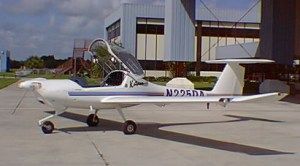 The Katana is sleek, sexy and modern-looking. |
The good news is that I flew a modern, good looking trainer that will enhance the imageof aviation and make a favorable impression on any new student at the airport. DiamondAircraft’s Katana DA20-A1 is a two seat, side-by-side low wing beauty that is one of thoseairplanes that look good standing still. Designed and manufactured by Diamond AircraftIndustries in London, Canada, the Katana is intended for primary flight training. It isconstructed of advanced composites and has a conventional low wing, T-tail and tricyclelanding gear. It is powered by a Bombardier Rotax 912F3, 81 horsepower four-cylinderengine with a recommended TBO of 1200 hours. Katana is also working on a Continentalpowered version, which would use the IO-240B producing 125 horsepower. The Rotax performedfine during our flight test, but Katana is anticipating the need for more power at higherelevations.
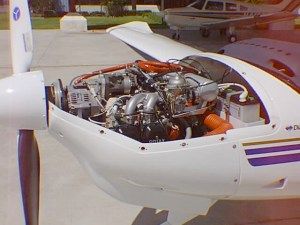 The Katana’s Rotax 912 engine and controllable wood/composite prop. |
The Rotax engine has several unusual features. It has two carburetors. By splitting thecarburetor duties between the two, Rotax was able to use smaller carburetors and find roomfor them on top of this compact engine. The propeller is driven through a reduction gearbox (2.27:1). This is transparent to the pilot who reads propeller RPMs on the tachometer.The engine also features an integral 20 amp alternator directly driven by the crankshaftand a 40-amp alternator driven off the pulley that is mounted to the propeller driveflange. The 20-amp alternator is used exclusively to power the dual capacitance dischargeignition system while the 40 amp alternator powers avionics, instruments and electricalaccessories. There is no vacuum system and all the instruments are electrically driven.There is no priming system for this engine, but there is a choke (!) which is used forcold starting only. There is no mixture control, the carburetors are automaticallyaltitude compensated.
The propeller is a hydraulically controlled constant speed with two blades. The propblades are of wood core construction with composite skins and aluminum or polycarbonatebonding edge inserts. There are really only two settings for the prop: Take off (full RPM)and cruise (2400 RPM) making it simple enough even for a student pilot.
Plastic, Not Aluminum
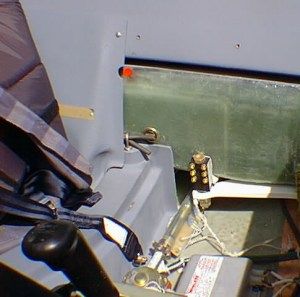 Katana’s composite wing spar. The red dot is the spar over-temperature indicator. (Oddly enough, all-red means okay.) |
The aircraft itself is of Glass-Reinforced Plastic (GRP) construction with localCarbon-Reinforced Plastic (CRP) in high stress areas. The Stressed fuselage skin primarilymade of a single GRP laminate with local GRP/PVC foam/GRP sandwich construction toincrease stiffness and reduce noise. It looks and feels tough. The seats are made of GRPand fixed in position. For different length legs the rudder pedals are adjustable. I foundthis to be the most undesirable part of the airplane- more about that later. The main wingspar is an I-section spar constructed of CRP spar caps that are joined with a GRP/foamsandwich spar web. I’ve seen less formidable I-beams holding up houses.
There have been rumors and claims about the instability of this construction in highambient temperatures. The spar does have a temperature limitation of 55 C or 131 F. Thereis an indicator located on the rear portion of the spar that is accessible by lifting theflap between the two seat cushions. The indicator is visible through the cut out in theseat back shells and is a round indicator with the numerals “55” on it. When thetemperature is below 55C the indicator is all red with the “55 barely visible, whenthe temperature of the spar rises above 55C then the red “55” is displayed on ablack background. Diamond claims that the limit is very difficult to reach except on thehottest of desert heat days. I flew the plane under the South Florida sun at an outsidetemperature of 90F and the spar never got close to temperature limits. Based on what Isaw, there should be no airport in the U.S. where you couldn’t operate the DA20 even onthe hottest day.
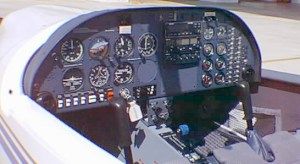 Katana’s front office features stick controls. |
Opening up the mostly Plexiglas canopy the interior looks like a modern sports car;That is, tight quarters, firm seats, neat looks and the smell of leather. “Let’s takethe Mazda Rx-7 up today”, it seemed to be saying. The radio stack is neatly done inthe middle of the panel, with engine instruments and circuit breakers on the right. Infront of the pilot is the usual “T” layout of flight instruments. The Katana isnot certified for IFR flight even though it looks equipped for it. Katana told us it wasdue to the lack of lightning protection. I know something aboutthat.
As I mentioned before there is no mixture control, just the throttle and prop RPM alongwith carburetor heat and cabin heat (we didn’t need that here in Florida). Flight controlsare operated by a stick mounted in the floor between each pilot’s legs. The stick is shortand doesn’t take up much room, but it gave me pause for thought as the last stick airplaneI flew was a Cub and that was some time ago. (I needn’t have worried.)
Let’s Go Flying!
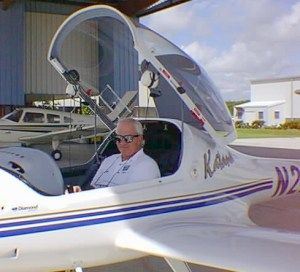 Time to fly the Katana (this is the fun part). |
Okay, time to fly (The best part.) Pre-flight is straightforward excepting for the spartemperature check, which we already mentioned. The book says is only needs to be checkedwhen the ambient temperature exceeds 100F. In the engine you have to check the coolantlevel as well as the oil quantity. There is one tank drain to check for water and the fuelis either on or off, no tank switching required. Once seated inside, you have to adjustthe rudder pedals to fit your legs. Using the toe/foot brakes required a foot movementthat I never quite mastered. A sort of swiveling of the ankle while holding the heal tothe floor but not to high up on the pedals…..well, I got it to work but it never feltgood and since the rest of the airplane seems so much in harmony with itself this traitstood out. The canopy can be held open with a latch for taxi but is closed for flight.
Starting the Rotax is a matter of electric fuel pump on, choke only if it is cold,cracking the throttle and turning the key/start switch. The small Rotax started soabruptly that it surprised me. It stops the same way; turn the key off and the enginestops immediately.
Starting to taxi takes a very small amount of throttle, as the airplane weighs only1600 pounds fully loaded. Steering, via differential braking using the rudder pedals wasawkward and I had some trouble getting my feet in the right position to use therudder/brakes. I did get better after some practice. The brakes and ground steering turnedout to be the only real item that I found unpleasant about the Katana.
A normal run-up, check the mags, cycle the prop and carb heat, flaps to T/O position,close the canopy, throttle up and release the brakes. At 51 Knots rotate and accelerate toclimb speed of 60 knots. At first the little stick is easy to over control because it isstiff and the little trainer reacts quickly and positively to control inputs. It stayedstiff but I got used to the quick response, after a while it began to make me feel like Iwas very “connected” to the airplane.
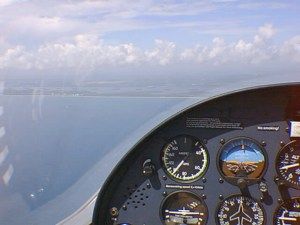 Visibility is exceptional in the Katana. |
Climb at full power, retract the flaps and set the prop at 2400 RPMs and hold best rateof climb (Vy) of 69 knots. The Katana climbs smoothly at about 500-600 fpm with two of usaboard and almost full fuel. Not spectacular, but very comfortable. It is easy to see whyat higher density altitudes or mountainous terrain the higher horsepower continentalversion might be a better choice. Here at sea level, even if it is hot (90F) the Rotax’sperformance is fine. The aircraft has exceptional stability, some due to the high frictionin the stick and some due to the design; put it in an attitude and it stays there. This isfine training for a student. When you enter a turn, neutralize the stick and the aircraftstays banked. No tendencies to shallow out or increase the bank. This feature is probablywhat caused me to hit our own propwash on my first steep 360 turn. At the time I thoughtit might be the pilot, but on further reflection I realize that the airplane had more todo with it. Noise levels are reasonable, and the built-in standard intercom is a featureI’d like to see in all trainers.
Putting It Through Its Paces
Stalls give plenty of aerodynamic warning and the long wing stays fully controllablethroughout. The Katana stalls at about 40 knots straight and level and about 55 knots in a45-degree bank. Departure stalls demonstrate the wing drop you would expect and theexcellent visibility afforded by the low wing and the bubble canopy make the experiencevery graphic as the sky, ground and the wings all stay visible throughout the maneuver.The Katana is approved for spins. In other trainers I have flown, the high wing or thecabin roof limit your visibility during attitude maneuvers and obstruct your vision enoughto make it hard to visualize where everything is in relation to the sky and ground. TheKatana has such great visibility because of the low wing, bubble canopy and lowglareshield that gives flying it a very open and airy experience. In fact, flying a planewith this kind of visibility is lots of Fun (with a capital F).
While not exactly designed for long cross-country work, the Katana will get you therein a reasonable time. Cruise speed varies between 110 and 120 knots and the little Rotaxburns 3.5-4.0 GPH, very economical. For even more economy, the engine is certified to runon automotive gas with a minimum octane of 90 and no added ethanol. With the greatvisibility, solid stability and good speed, the Katana would be fun to fly from here tothere. A student would also have the advantage of good ground visibility to help in hisfirst cross-country trips. Stated range in the flight manual is 523 nm but we didn’t testthat.
After some airwork it was time to see how the Katana handled close to the ground.Reduce power (remember carburetor heat if needed) and the Katana stars down without muchwind noise due to the smooth airflow over the rounded canopy. For landing the electricfuel pump is on, and T/O flaps (15 degrees) are used to help slow down and go down.Approaching at 57 knots is comfortably above stall and gives good control response. Iwould guess that a student would be overcontrolling in this area of flight, I like to seestudents correcting wings down with a rapid response particularly as we get close to theground, but the Katana is very responsive and will take some getting used to. It istouchier in pitch than roll and once again, the short stick will take some getting usedto. As a personal preference, I like sticks; they take up less room, get in the way lessand are more intuitive. An airplane is not a car and really doesn’t need a wheel.
I brought the Katana close to the runway and held it there just waiting. Without muchfloat, and with good deceleration with full flaps the trainer touched down more smoothlythan my first landing ought to have been- once again while I’m good, I’m not that good,the airplane had lots to do with it. Roll out was short and we taxied back for some shortfield takeoffs and landings. I pushed the envelop a little for a short/soft field takeoffkeeping the stick back and then lowering the nose when the airplane first lifted off. Thiscan be tricky for students, but the Katana seemed to feel as solid here as it dideverywhere else.
Approaching at 50 knots instead of 57 knots still left plenty of margin before a stallbut resulted in less float and a more positive touchdown (read: not a squeaker).Actual touchdown speeds are very low and the aircraft can be stopped in a very shortdistance.
One Fun Airplane…
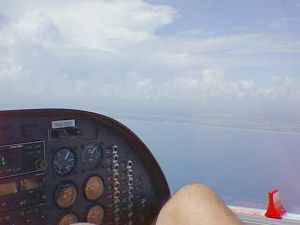 The Diamond Katana: one FUN airplane! |
Flying the Diamond Katana is fun. It looks good and feels the same way. The Rotaxengine starts quickly and easily and has good throttle response. The controls are stiffbut very effective. It is easy to fly and has lots of visibility. It might take a studentsome time to handle the rudder/brake interaction and the quick controls also take sometime to get used to. The airplane says, “let’s fly!” just sitting on the ramp.
Diamond claims that the airplane is extremely easy to maintain. 100 hour inspectionsare quick and easy to do and the Rotax engine is inexpensive to maintain and overhaul.Airport or flight school operators should be able to look forward to reduced operatingcosts over older trainers they may have been using.
The Katana has a clear edge over older trainers but it is less clear how it will fareagainst the new Cessna 172s or other established trainers, which may go into newproduction. That’s why there is still Ford and General Motors; people’s opinions differ onlots of subjects, cars and airplane trainers being only two of them. There is definitelyroom in the market for a trainer that looks and flies as good as this one does. The Katanagives you the feeling of flying with its great visibility and quick controls. If theairplane is flown 200 hours a year, lower-operating costs may also factor into theequation.
If we could get student starts to increase with the GA Team 2000 program, the EAA’sYoung Eagles program and others, the market for new trainers would heat up. There may besome “cat chasing his own tail” going on, because if we had more attractivetraining aircraft we might attract more students which might require more attractivetraining aircraft and so on. No one buys Mooney, a high performance Piper, or any advancedaircraft without learning to fly first. Making that experience a good one is important tothe future of General Aviation. The Diamond Katana is a good start.


































